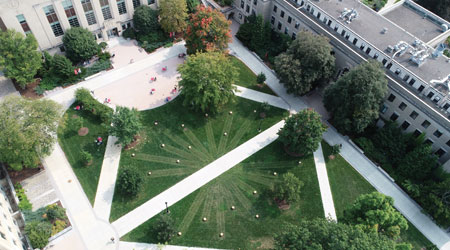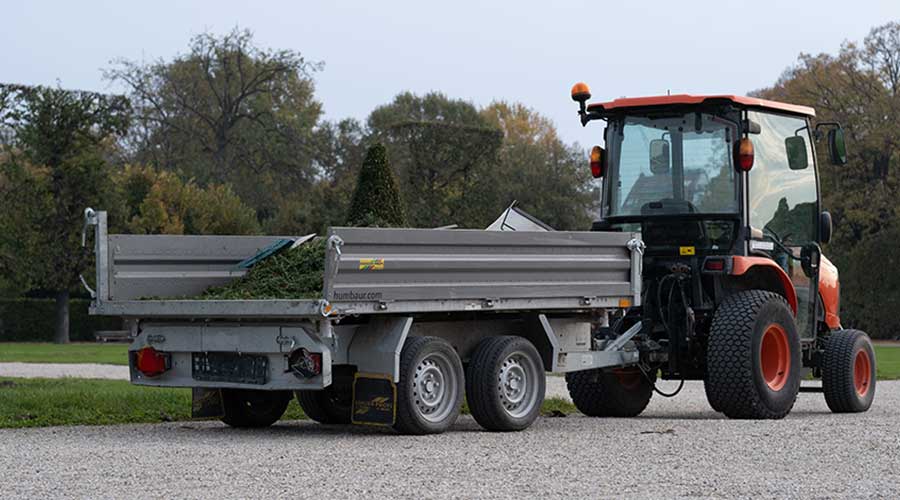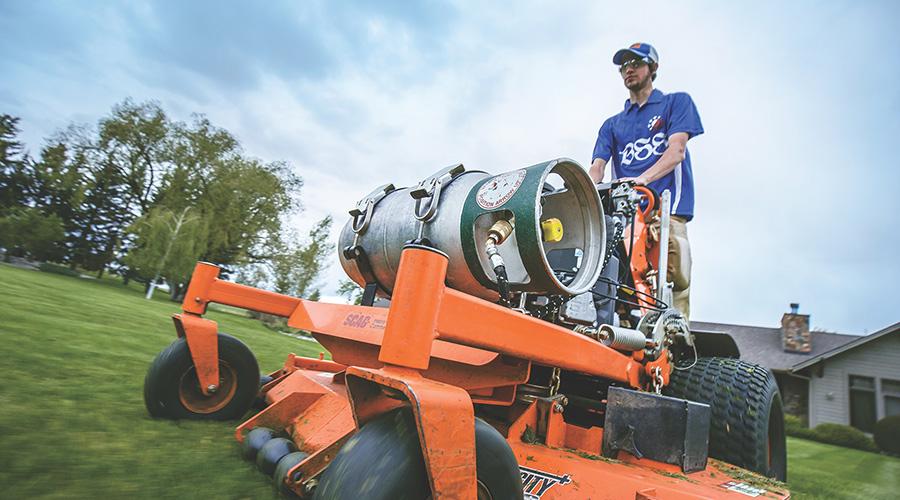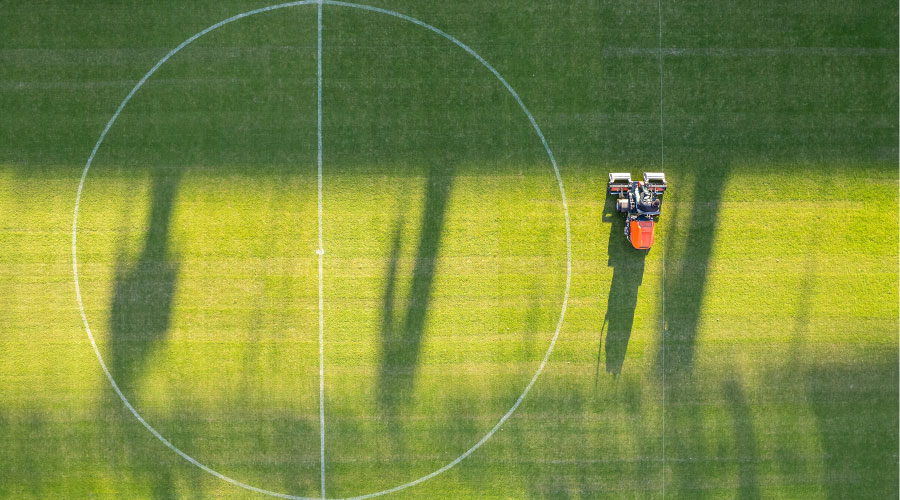 Mowing patterns on the Cornell University campus are designed to educate visitors about social distancing.Cornell University
Mowing patterns on the Cornell University campus are designed to educate visitors about social distancing.Cornell UniversitySustainability in Grounds Care: One University's Success Story
A cutting edge approach to turf care moves Cornell University to the head of the class.
No segment of the institutional and commercial facilities market emphasizes appearance as much as higher education. Colleges and universities compete fiercely to attract professors and students, and their facilities and landscapes are crucial components in making a solid first impression.
This competition is especially tough among Ivy League schools, and one person who understands the dynamic very well is Daniel Schied, director of grounds with Cornell University, whose department plays a key role in creating that all-important first impression for his institution. For Schied and his team, the challenge is to perform mowing and turf management duties both effectively and sustainably — a high priority in higher education.
“Cornell puts such a high emphasis on sustainability,” Shied says. That emphasis has a strong influence on the goals of mowing activities and the long-term decisions related to campus appearance.
The grounds care team
Cornell’s main campus covers about 1,000 acres, with 310 acres of lawn and 80 acres of shrubs and tree plantings. The campus also includes 15 miles of roads, 61 miles of sidewalks and 114 acres of parking lots.
“My department does both landscapes and utility digs,” Schied says. ”We have a construction division that does some construction work on campus, such as sidewalk or asphalt work. A lot of what we do is utility infrastructure, such as drain replacements and hydrant replacements.
“That group has eight staff members and one manager. Under the construction division is the second and third shift of three people and three mechanics. Third shift is primarily eyes and ears. In the wintertime, it’s being out on the roads and making sure they’re staying salted, and cleaning the parking garages where there are no cars there.”
The department’s landscape division has two managers and 30 staff members broken up into five zones.
“We are a partial private, partial state institution, so we have our endowed campus and our state campus, and we have two residential campuses that are maintained by a crew,” Schied says. “Our east campus requires mowing in some large areas, and we took over the mowing in our campus arboretum.”
Equipment considerations
Schied’s mowing operation uses about 20 pieces of equipment, including zero-turn mowers, walk-behind mowers, and stand-on mowers.
“We have a couple of 11-foot mowers that we share among the teams because we don’t have enough large areas to make it worthwhile to have one in each zone,” he says. “We have one mower that we can use on slopes because it’s a little safer. We put double tires on each side of the axle. For the real steep slopes — the ones that we only mow once a year and have allowed to go to meadows — we have a radio-controlled mower on slopes that we don’t want to put people on.”
Equipment operators place a high priority on maintaining mowers properly to ensure long-performance life.
“We try not to let our equipment get to the point where it’s continually breaking down,” Schied says. “We try to trade some things in while there’s still some value to them. Really, one of the keys for us is maintaining reliable equipment because the efficiencies lost and the dollars lost due to not being able to perform your work probably outweigh the actual cost of keeping equipment well-maintained. Every day, when the equipment comes in, it gets washed. The same thing is true after we’ve been out plowing and salting sidewalks.”
When the time does come for replacement, Schied says selection is a team effort.
“We look for cost, comfort and durability,” he says. “We get equipment demos whenever we can. When there’s something new to try, we bring in our staff, including our team leaders and mechanics. We ask for their review and comments on it.”
Spotlight on sustainability
Because of the need to balance aesthetics and sustainability on campus, one key goal of the department’s mowing activities is to maintain attractive turf without too many weeds and do it in an environmentally friendly way.
“That’s where the culture comes into play — keeping things healthy,” Schied says. “Thick dense turf is not going to allow weed seeds to germinate because you’re not allowing the sun to get to the soil level. We mow the grass a little bit higher — about 3 and a half inches. Leaving it a little longer reduces weed seed germination and allows for a deeper root system, and it allows you to mow a little less frequently with a little more drought tolerance.”
Spring can be an especially challenging time to balance the priorities of appearance and sustainability.
“The biggest challenge in May is keeping ahead of that one-third rule — where you take off just one-third of a blade of grass at a time — because things are just growing like crazy. It’s been damp and rainy the last week, and it just compounds the challenge,” he says.
The department’s sustainability turf management includes judicious use of chemicals.
“On the occasions you do use an herbicide, make sure it’s done at a time when students are not around and the campus is not overly occupied,” Schied says. “That doesn’t always meet the best timing windows for herbicides, but we will sacrifice the efficacy of the product for the safety and the concern for people. We try to do the fewest herbicide treatments possible.
“We’re not as concerned about fertilizers because they tend to not have the same level of toxicity. If we can fertilize and keep things healthy, we’ll do that because that will reduce the weed pressure. We use almost no insecticides on the lawns. If you have a healthy lawn, it can survive some grub pressure and outgrow the grubs.”
Sustainability considerations also include careful planning for irrigation and stormwater management on campus.
“We have very few irrigated areas,” Schied says. “Most of the campus is designed to operate without irrigation. Being in the Northeast, that’s a little easier to do than it is in the South and the Southwest.
“Rain gardens and bioswales are huge for us, and for every project we build, they are part of our stormwater management. We’re putting in a new dorm complex that has probably a dozen of them among the buildings. The rain gardens are somewhat self-sufficient; they don’t require mowing.”
Moving to meadows
Among the most noticeable changes to campus landscapes in recent years is the move away from about 25 acres of turf requiring mowing to what Schied calls meadows.
“One reason we’re doing it is to create pollinator habitats,” he says. “When we first started doing it, we were primarily looking at the environmental benefits as opposed to all the ecological benefits that you can get by creating a pollinator habitat, as well. We’ve moved (the meadows expansion) to a lot of sloped areas that are a little dangerous to mow.”
The success of the meadows areas involves an education effort by the department targeting students, staff and faculty used to seeing only manicured turf areas on campus.
“The meadows started before I got here, and we’ve expanded the meadows since then,” he says. “When you’re doing something different, if you can educate folks and put out a graphic as to why you’re doing it, that was important to me. An unmowed area looks like your mower broke down or that you’re just too lazy to do it.”
The education efforts include placing signs near meadows — “Tall Grass. Small Gas” — with a sustainability message that explains the reason for the transition from mowed turf to meadows.
“We do the same kind of education in the wintertime to educate folks that there are things you need to be safe. Walk with your center of gravity over your feet. Don't take long steps. The key is to explain to people what you’re trying to accomplish.” (Stop winter falls. Walk like a penguin.)
Pandemic impact
As with every other area of facilities over the last 15 months, the COVID-19 pandemic has had an impact on Schied’s department. One especially visible impact relates to mowing activities on several turf areas on campus after someone approached the university architect to create outdoor spaces that indicate social distancing.
“We asked how we can educate students or anyone who uses the campus about how much is 6 feet,” Schied says, “With a sunburst, each of the rays is 6 feet wide, and the circles are 12 and 24 feet — multiples of 6 feet. We did a 6-foot checkerboard pattern in one of our quads last summer, but it didn’t really work. We had a drought, and the lawn didn’t have enough succulent growth to really show it.”
The process of developing the mowing patterns extended beyond the department to incorporate student input.
“A group of students designed various ideas,” Scheid says. “Some were not viable. With some of the patterns, we would have had to be the Yankees groundskeepers to create the patterns they were looking for.”
The project also involved the creative use of landscape materials from other grounds management activities.
“Because of emerald ash borers, we’re taking down ash trees, so we cut the trunks into stumps that students could sit on or lean against when they sit on the ground, so the dots in the rays of the sunburst are 18-inch-tall ash logs,” Scheid says.
Related Topics:













